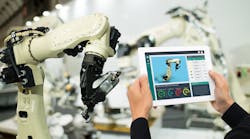Rethinking the Norm: 5 Ways Manufacturing Will Innovate in 2021
While COVID-19 was a challenge for the industry, many manufacturers have found creative ways of creating value for their customers and the broader community, often enabled by technology. Whether it’s providing ventilators and PPE during shortages or even resuming investments in new digital factory plans, manufacturers have demonstrated their ability to pivot, experiment with new operating models, and still push forward during uncertainty.
The pandemic galvanized the industry to establish new norms that will have impactful, transformative effects for decades to come. And as we enter almost 12 months of operating within a new norm, 2021 will continue to see the entire manufacturing ecosystem innovate, thanks to the continued adoption of new technologies at record pace. Here are five trends to be on the lookout for within the New Year:
Artificial intelligence and machine learning will have a critical role in helping mitigate COVID-19 cases on the shop floor.
For times when working remotely may not be feasible and coming onto a physical property is necessary, maintaining six feet of physical distance at minimum may still be required. Artificial intelligence (AI) and machine learning (ML) have the potential to fill the gaps between employees and physical machinery. For example, AI can free workers from repetitive processes and automatically reassign workers to distanced stations. It can enable more machines to be remotely monitored through dashboards and performance reviews, and detect quality and conformance conditions around the clock.
Already, we’re seeing an explosion of AI pilots for manufacturing, but most haven't scaled AI use just yet. In a recent study we conducted, though, over a third (37%) of manufacturers said they’re ramping up AI/ML use in response to COVID-19. This heightened need for AI help and better ease of use will accelerate scaling in 2021. We’ll see even more long-term implementations as AI becomes simpler, more cost-efficient—and subsequently more industrialized. As a result, AI will start to become second nature for manufacturers, all to help further prevent the spread of COVID-19 on the shop floor.
As new technology platforms proliferate, standardization through open source will become essential.
While on-prem may be the default for many manufacturers, nonetheless, there’s been an explosion of new technology platforms to explore. Our internal research has found that manufacturers are experimenting with disruptive technologies and digital enablers at unprecedented rates; our recent study also revealed that 76% of manufacturers have increased the use of digital enablers and disruptive technologies, in light of the pandemic.
But just as important as it is for manufacturers to have access to the best-of-breed offerings, it’s even more critical that these offerings all cohesively work together. Open source is a proven way to implement standardization and unite siloed technology. It has many benefits, from supporting workloads across on-prem and multiple clouds, to providing tighter security and discouraging vendor lock-in. Open source will take on an even greater role within manufacturing in 2021, no matter the technology platform at hand.
Sustainability will become a renewed priority within Industry 4.0.
Sustainability is a secular trend that has dominated the public discussion before the pandemic and will do so again soon. Already, there are many manufacturers demonstrating their commitment to meeting global sustainability goals, such as Volvo Cars globally tracing cobalt use in its electric vehicle batteries to ensure raw materials have been ethically sourced. Additionally, governments and organizations alike are paying more attention to and measuring the sustainability aspects, including better understanding their own carbon and ecological footprints. The global non-profit climate research provider CDP noted a 45% year-over-year increase of companies securing its “A score,” which measures commitment to environmental transparency and action.
As manufacturers further automate factory floors, it’s also an opportunity to intuitively build sustainability into their efforts. That includes prioritizing green-focused IT vendors to work with and lean further into efficiently digitizing parts of the supply chain.
Tangible 5G use cases will emerge, with manufacturing leading the way.
Unquestionably, 5G will play an important role in Industry 4.0’s transformation, with endless promises—from enabling warehouse automation, to collecting and structuring industrial data for the cloud, and serving AR/VR content to factory technicians for machine diagnostics. 5G can also bring key technologies like AI/ML and analytics onto an enterprise’s premises, all to decrease latency and subsequently deliver better service to end users.
5G has already seen considerable growth this year, including Verizon’s expansion in the United States and Nokia and Togocom’s planned launch in West Africa. As more coverage areas emerge next year, more 5G scenarios will move from the pilot phase and into real-life use cases. In ways we haven’t previously seen, 5G will transform the way products are made and supply chains are managed in 2021.
Connected remote work will become the norm, rather than the exception.
Tech companies aren’t the only companies to instill more work-from-home practices; traditional manufacturers are starting to endorse remote work in leaps and bounds, too. Earlier this summer, Siemens embraced a more mobile workforce that could spend several days working away from the office. In fact, The Conference Board notes that within the manufacturing sector, the percentage of U.S. full-time employees working primarily from home (at least three days each week) significantly increased from 7% to almost a third (32%).
A culture shift is happening, where even the most conservative companies are realizing the benefits and ease of connectedness that digital collaboration tools can bring. As more and more manufacturers get even more comfortable with these tools and their benefits, we’ll see a lot more openness to a “new work remotely norm” taking place in 2021.
Manufacturers have a lot to be proud of over a difficult 2020. They’ve navigated through unique challenges—and ended up in a better place by reevaluating technology across their operations. Next year will see manufacturers taking advantage of new tools, ranging from AI to open source and to 5G to thrive in the aftermath of the pandemic, and beyond.
Dominik Wee is managing director, Global Manufacturing, Industrial and Transportation, at Google Cloud. He is responsible for Google Cloud's global business with companies in this sector, including industrial goods, automotive OEMs and suppliers, electronics, energy, aerospace and defence, and transport and logistics service providers.




